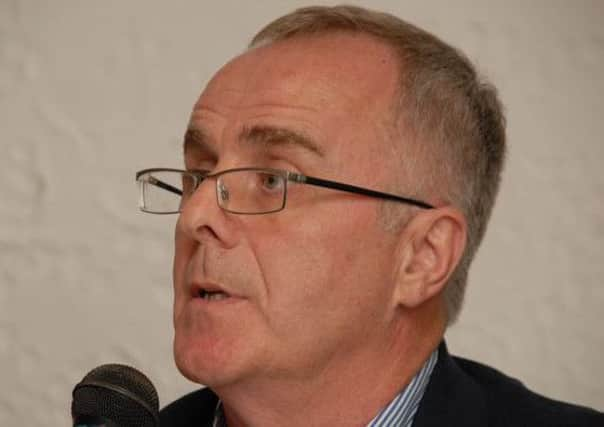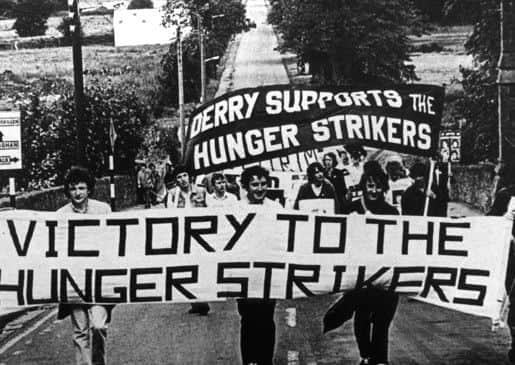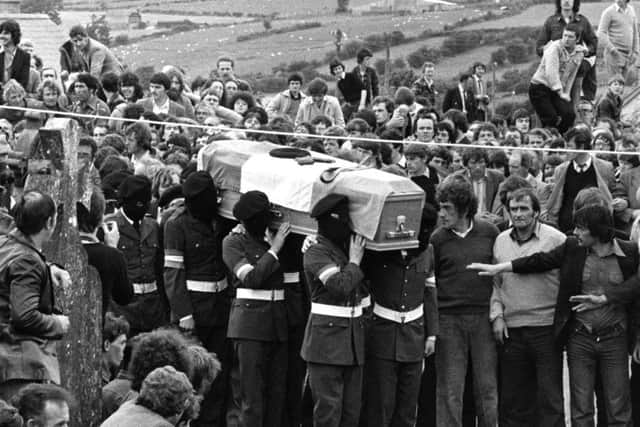1981 hunger strike: Sinn Fein MLA recalls the prison protests 35 years on


The ‘no-wash’ protests by 1980 gave way to a hunger strike, but after that broke down, in March, 1981, Bobby Sands was the first to embark on a second hunger strike which by October that year saw ten men die and dozens more die across the North as violence exploded on to the streets outside.
The first hunger strike began on October, 27, 1980. The protesters set out their stall under a list five demands: 1-The right not to wear a prison uniform; 2-The right not to do prison work; 3-The right of free association with other prisoners;4-The right to organise their own educational and recreational facilities and 5-The right to one visit, one letter and one parcel a week.
Advertisement
Hide AdAdvertisement
Hide AdSeven men, including Foyle Sinn Fein MLA, Raymond McCartney said they would fast to the death in the pursuit of the re-establishment of political status. Three women in Armagh Jail also embarked on the strike.


A deal offered by the British Government, appearing to offer the prisoners the right not to wear a prison uniform was made as Christmas approached. With one of the men, Sean McKenna close to death, the strike was called off. When it later emerged that what actually was on offer was a ‘deal’ to allow prisoners to wear ‘civilian type clothing’ supplied by the prison authorities the scene was set for another hunger strike.
Raymond McCartney told the ‘Journal’: “Obviously everybody’s memory of 1981 is the fact that ten people died on hunger strike.
“On March 1, 1976 the British Government removed political status. I think most people thought that this was a half-hearted attempt and they’d roll over within a short period of time. But, clearly what was emerging was a complete change in policy by the British Government who were intent on the idea of ‘normalisation’, ‘criminalisation’ and ‘Ulsterisation’.
Advertisement
Hide AdAdvertisement
Hide Ad“Instinctively, any of us who found ourselves in prison at that time, knew we were political prisoners and any attempt to criminalise us just wasn’t going to work. It became a battle of wills.


“But, I think by the end of the hunger strike in October, 1981, most people looking on were saying that whatever was going on in the North that nobody in their wildest notion thought it was a criminal conspiracy. They certainly saw it as a political conflict. They may not have agreed with the armed actions of the IRA, but they certainly viewed it as a political situation.
“So for us, by that stage, the process of criminalisation was in tatters. But, there was a very high price paid because 10 people had died in prison and 60 or 70 people had died on the streets.
“Within the prisons we knew that we still had work to do because what we had to do was turn that acceptance of political imprisonment into every day conditions. By the end of the hunger strike I suppose there was a big recognition of the difference between the criminals uniform and our own clothes was one manifestation of it. And, over the years we continued to ensure the conditions in Long Kesh reflected that.
Advertisement
Hide AdAdvertisement
Hide Ad“By the late 1980s and early 1990s, journalists were frequent visitors to the prison and left with the overwhelming impression that we were a ‘different type’ of prisoner. They may have gone out and had questions about who you were and what you were about but they were in doubt that we were political prisoners. That was a big source of validation.”


The intensity of the events and scale of death and destruction between 1976 and 1981 in retrospect now seems enormous, but Raymond McCartney maintains that it paved the way for future political developments.
“It was only five years, but it was a very intense five years. It is only when you get a bit older you realise just how short a time span it was, because when you roll onto 1998 and the Good Friday Agreement there was an acceptance of the framework that there was a political conflict which had to be resolved by political means-the recognition of political mandates, the political framework to address all these issues, but at the core of that was the acceptance of political prisoners.
“There is no doubt there is evidence that there were elements within the British Government determined that political status should not be granted for whatever reason. Even in 1972, there was internment without trial and up to 1,000 people were held in conditions. They wore their own clothes. There was a recognition of the political conflict of one nature or another. How that was defined by different people is a different matter. I know that other people have made the observation that for too long the British tried to deal with the North as a security issue. therefore, when you have a security mentality or emergency laws, emergency courts, emergency interrogation centres, everything is changed and turned upside down.
Advertisement
Hide AdAdvertisement
Hide Ad“If you follow their logic from that point of view and they say ‘you cannot now say you are political prisoners’ whilst trying to pretend that everything else about the situation isn’t political too then the penny drops in a whole lot of ways.”


The years since 1981 have provoked much debate within wider nationalism about whether or not the hunger strike was harnessed as a catalyst for the republican movement to embark on the path to politics. The election of Bobby Sands to Westminster and Kieran Doherty to the Dail was followed quickly by a debate within Sinn Fein about ending their policy of abstentionism from political institutions that would lead to a split in the movement in 1986. The ‘Journal’ asked Raymond McCartney about his view on this.
He said: “It is interesting now, because everyone has their story about what the origins of the peace process was. But, there is absolutely no doubt that when you look back as far as 1982 that Gerry Adams that there needed to be a political way of resolving the conflict, because military stalemate was exactly that. The famous Glover Report from the British Army accepted that there was not going to be a military defeat, was them in their own way, saying the IRA was a political force and that the guys in Long Kesh were political prisoners. They job they were sent to do, they couldn’t do and that was to impose a military defeat and by extension their laws of oppression were not going to work either.
“It made the situation painful and made the conflict last longer. Then, whenever the formula for the Good Friday Agreement was put forward, some former prisoners will tell you that it was too high a price to pay, but the core accepted it was a political problem and without political solutions it was never going to be resolved.”
Advertisement
Hide AdAdvertisement
Hide AdWhen the first hunger strike ended in October of 1980, Raymond McCartney had gone without food for 53 days. So, what are his own personal recollections of the physical effects of what took place?
I suppose when you look at that time in 1981, Martin Hurson died after 46 days whilst others like Kevin Lynch were approaching 70 days when he died. In a very strange way hunger strike affects different people in different ways. Even the day the hunger strike ended in 1980, I was still walking about, I was out of bed. But, there is no doubt that your body slows down. My ability to see was greatly affected, but, the body is a remarkable piece of equipment and resilience is obviously built in. As you get older you reflect on it and it is difficult to work out in your head that you could sustain doing without food for 53 days and others for 66 days.
“I view the act of hunger strike as a two-phase thing. There is a phase when you are ending it that your body tells you that it is shutting down. When you speak to people like Laurence McKeown, who slipped into a coma he’ll tell you that there are definite signals that you were coming to the end of your life.


“That’s the second phase and it’s something that I wasn’t faced with. I think that if I had been in that position, I could have died and I would have died, but I didn’t face it. But, I have talked to Laurence McKeown who did face it. He says he was very, very aware that his body was closing down. People have asked me do you think you would have died but it’s difficult to answer because I wasn’t faced with it but I had certainly prepared for it.
Advertisement
Hide AdAdvertisement
Hide Ad“There’s always the sense that the first hunger strike ended unsatisfactory. There’s no doubt about that. People will say that the prisoners were out manoeuvred, but we believed in good faith that there could have been a solution and we wanted it to be resolved. It wasn’t about trying to defeat or crush anybody, it was about giving us what we were entitled to. But there was always the sense ever since that it was like somebody throwing you the ball and you dropped it, through no fault of your own, but you’d still dropped it and someone else had to come along and pick it up. That’s why I have the greatest admiration for the people who went on the second hunger strike, because whatever doubts there were about what going to happen with the first strike, Bobby Sands knew what was going to happen. And, when Bobby Sands died the other hunger strikers were in no doubt that the next phase was death.
“I don’t think you can really ever put yourself in that position to imagine what their thought processes were.”
Undoubtedly, it was Margaret Thatcher more than anyone else within the British establishment at the time who demonstrated complete determination to use the protests in Long Kesh to divide and break the republican movement. Many commentators have pointed to the INLA assassination of her colleague Airey Neave in 1979 as one reason why the British Prime Minister embarked on a path of total intransigence towards the IRA. However, Raymond McCartney believes that he thinking was a lot wider than that.
“Whatever her antipathy towards Ireland was and what came with that, she was setting out a broader political stall. Look at how she treated the miner’s later on. Reading state papers now, 30 years after these events, her take on the miner’s strike wasn’t just a battle about conditions in the mines, it was about strategically tackling trade unions. It was a case of her saying who is the strongest union-who is the spine of the working class and acting on that,” he said.
Advertisement
Hide AdAdvertisement
Hide AdAs the centenary of the Easter Rising is fast approaching, the ‘Journal’ asked the Sinn Fein if the ideals as laid down in the Proclamation of the Irish Republic was something that was discussed or considered during the prison protests of the 1970s and 80s?
Raymond McCartney said: “I think you have to be honest with yourself and say that when we grew up in this city, and I am not saying that politics was prevalent, but you had a very clear idea that something was wrong and it appeared there was always the inability to do anything about it. There was gerrymandering and the city corporation. We’ve all heard stories about people who had never set foot in the Guildhall until their later years because it was seen as place belonging to unionists. Sometimes, that might be overstated, but that was the perception.
“I always remember that being in jail gives you the time to reflect and read and think and I also always remember that Bobby Sands out of all the people who had been in jail was very clear about what he was there for because he wrote it all down. Some of the things he wrote captures the way a writer works-it’s all encompassing and puts it out there in a very vivid way.
“I had previously been interned, I had an understanding about what being a political prisoner was. You had your own clothes and a bit of freedom to associate with other prisoners and you didn’t feel that sense of captivity although you were locked up. Bobby Sands caught on very early that the British were trying to defeat us in the prisons. It wasn’t just about trying to give you a hard time or denying you your own clothes, it was that they had a core idea to break us.
Advertisement
Hide AdAdvertisement
Hide Ad“One of the rewarding things for me personally was that the system we had in the end in jail was one based on equality. That we treated people as equals. If you couldn’t treat the person beside you as a comrade and an equal that you couldn’t expect anyone else to believe that you’d treat all people as equals as you went on through life.”